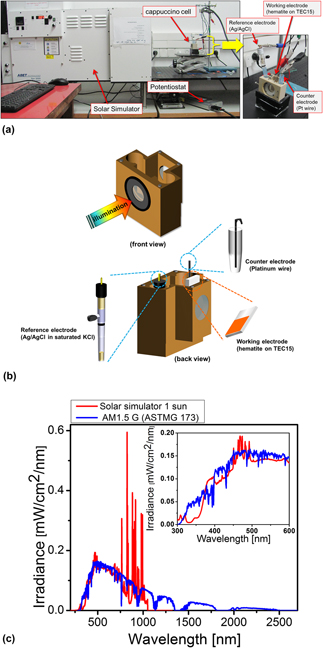Crossref Citations
This article has been cited by the following publications. This list is generated based on data provided by
Crossref.
Grave, Daniel A.
Dotan, Hen
Levy, Yossi
Piekner, Yifat
Scherrer, Barbara
Malviya, Kirtiman Deo
and
Rothschild, Avner
2016.
Heteroepitaxial hematite photoanodes as a model system for solar water splitting.
Journal of Materials Chemistry A,
Vol. 4,
Issue. 8,
p.
3052.
Gross Koren, Moran
Dotan, Hen
and
Rothschild, Avner
2016.
Nano Gold Rush: On the Origin of the Photocurrent Enhancement in Hematite Photoanodes Decorated with Gold Nanoparticles.
The Journal of Physical Chemistry C,
Vol. 120,
Issue. 28,
p.
15042.
Niv, A.
Koren, M. Gross
Dotan, H.
Bartal, G.
and
Rothschild, A.
2016.
Separation of light confinement and absorption sites for enhancing solar water splitting.
Journal of Materials Chemistry A,
Vol. 4,
Issue. 8,
p.
3043.
Grave, Daniel A.
Klotz, Dino
Kay, Asaf
Dotan, Hen
Gupta, Bhavana
Visoly-Fisher, Iris
and
Rothschild, Avner
2016.
Effect of Orientation on Bulk and Surface Properties of Sn-doped Hematite (α-Fe2O3) Heteroepitaxial Thin Film Photoanodes.
The Journal of Physical Chemistry C,
Vol. 120,
Issue. 51,
p.
28961.
Kay, Asaf
Grave, Daniel A.
Ellis, David S.
Dotan, Hen
and
Rothschild, Avner
2016.
Heterogeneous Doping to Improve the Performance of Thin-Film Hematite Photoanodes for Solar Water Splitting.
ACS Energy Letters,
Vol. 1,
Issue. 4,
p.
827.
Segev, Gideon
Dotan, Hen
Malviya, Kirtiman Deo
Kay, Asaf
Mayer, Matthew T.
Grätzel, Michael
and
Rothschild, Avner
2016.
High Solar Flux Concentration Water Splitting with Hematite (α‐Fe2O3) Photoanodes.
Advanced Energy Materials,
Vol. 6,
Issue. 1,
Landman, Avigail
Dotan, Hen
Shter, Gennady E.
Wullenkord, Michael
Houaijia, Anis
Maljusch, Artjom
Grader, Gideon S.
and
Rothschild, Avner
2017.
Photoelectrochemical water splitting in separate oxygen and hydrogen cells.
Nature Materials,
Vol. 16,
Issue. 6,
p.
646.
Kay, Asaf
Grave, Daniel A.
Deo Malviya, Kirtiman
Ellis, David S.
Dotan, Hen
and
Rothschild, Avner
2017.
Wavelength Dependent Photocurrent of Hematite Photoanodes: Reassessing the Hole Collection Length.
The Journal of Physical Chemistry C,
Vol. 121,
Issue. 51,
p.
28287.
Malviya, Kirtiman Deo
Klotz, Dino
Dotan, Hen
Shlenkevich, Dmitry
Tsyganok, Anton
Mor, Hadar
and
Rothschild, Avner
2017.
Influence of Ti Doping Levels on the Photoelectrochemical Properties of Thin-Film Hematite (α-Fe2O3) Photoanodes.
The Journal of Physical Chemistry C,
Vol. 121,
Issue. 8,
p.
4206.
Klotz, Dino
Grave, Daniel A.
and
Rothschild, Avner
2017.
Accurate determination of the charge transfer efficiency of photoanodes for solar water splitting.
Physical Chemistry Chemical Physics,
Vol. 19,
Issue. 31,
p.
20383.
Ren, Haiyan
Zou, Xiaoping
Cheng, Jin
Ling, Tao
Bai, Xiao
and
Chen, Dan
2018.
Facile Solution Spin-Coating SnO2 Thin Film Covering Cracks of TiO2 Hole Blocking Layer for Perovskite Solar Cells.
Coatings,
Vol. 8,
Issue. 9,
p.
314.
Piekner, Yifat
Dotan, Hen
Tsyganok, Anton
Malviya, Kirtiman Deo
Grave, Daniel A.
Kfir, Ofer
and
Rothschild, Avner
2018.
Implementing Strong Interference in Ultrathin Film Top Absorbers for Tandem Solar Cells.
ACS Photonics,
Vol. 5,
Issue. 12,
p.
5068.
Jung, Sejin
Kim, Jung Hyun
Ko, Jang Myoun
and
Choi, Wonseok
2018.
A Study on the Annealing Ambient Effect on the Anti-Pollution Characteristics of Functional Film for PV Modules.
Applied Sciences,
Vol. 8,
Issue. 11,
p.
2285.
Zhao, Y.
Balasubramanyam, S.
Sinha, R.
Lavrijsen, R.
Verheijen, M. A.
Bol, A. A.
and
Bieberle-Hütter, A.
2018.
Physical and Chemical Defects in WO3 Thin Films and Their Impact on Photoelectrochemical Water Splitting.
ACS Applied Energy Materials,
Vol. 1,
Issue. 11,
p.
5887.
Sinha, Rochan
Lavrijsen, Reinoud
Verheijen, Marcel A.
Zoethout, Erwin
Genuit, Han
van de Sanden, Mauritius C. M.
and
Bieberle-Hütter, Anja
2019.
Electrochemistry of Sputtered Hematite Photoanodes: A Comparison of Metallic DC versus Reactive RF Sputtering.
ACS Omega,
Vol. 4,
Issue. 5,
p.
9262.
Zhao, Yihui
Brocks, Geert
Genuit, Han
Lavrijsen, Reinoud
Verheijen, Marcel A.
and
Bieberle‐Hütter, Anja
2019.
Boosting the Performance of WO3/n‐Si Heterostructures for Photoelectrochemical Water Splitting: from the Role of Si to Interface Engineering.
Advanced Energy Materials,
Vol. 9,
Issue. 26,
Li, Guangdong
Zou, Xiaoping
Cheng, Jin
Chen, Dan
Yao, Yujun
Chang, Chuangchuang
Yu, Xing
Zhou, Zixiao
Wang, Junqi
and
Liu, Baoyu
2020.
Impact of Perovskite Composition on Film Formation Quality and Photophysical Properties for Flexible Perovskite Solar Cells.
Molecules,
Vol. 25,
Issue. 3,
p.
732.
Wang, Junqi
Zou, Xiaoping
Zhu, Jialin
Cheng, Jin
Chen, Dan
Bai, Xiao
Yao, Yujun
Chang, Chuangchuang
Yu, Xing
Liu, Baoyu
Zhou, Zixiao
and
Li, Guangdong
2020.
Effect of Optimization of TiO2 Electron Transport Layer on Performance of Perovskite Solar Cells with Rough FTO Substrates.
Materials,
Vol. 13,
Issue. 10,
p.
2272.
Scherrer, Barbara
Li, Tong
Tsyganok, Anton
Döbeli, Max
Gupta, Bhavana
Malviya, Kirtiman Deo
Kasian, Olga
Maman, Nitzan
Gault, Baptiste
Grave, Daniel A.
Mehlman, Alexander
Visoly-Fisher, Iris
Raabe, Dierk
and
Rothschild, Avner
2020.
Defect Segregation and Its Effect on the Photoelectrochemical Properties of Ti-Doped Hematite Photoanodes for Solar Water Splitting.
Chemistry of Materials,
Vol. 32,
Issue. 3,
p.
1031.
Bosso, Piera
Milella, Antonella
Barucca, Gianni
Mengucci, Paolo
Armenise, Vincenza
Fanelli, Fiorenza
Giannuzzi, Roberto
Maiorano, Vincenzo
and
Fracassi, Francesco
2021.
Plasma‐assisted deposition of iron oxide thin films for photoelectrochemical water splitting.
Plasma Processes and Polymers,
Vol. 18,
Issue. 1,



